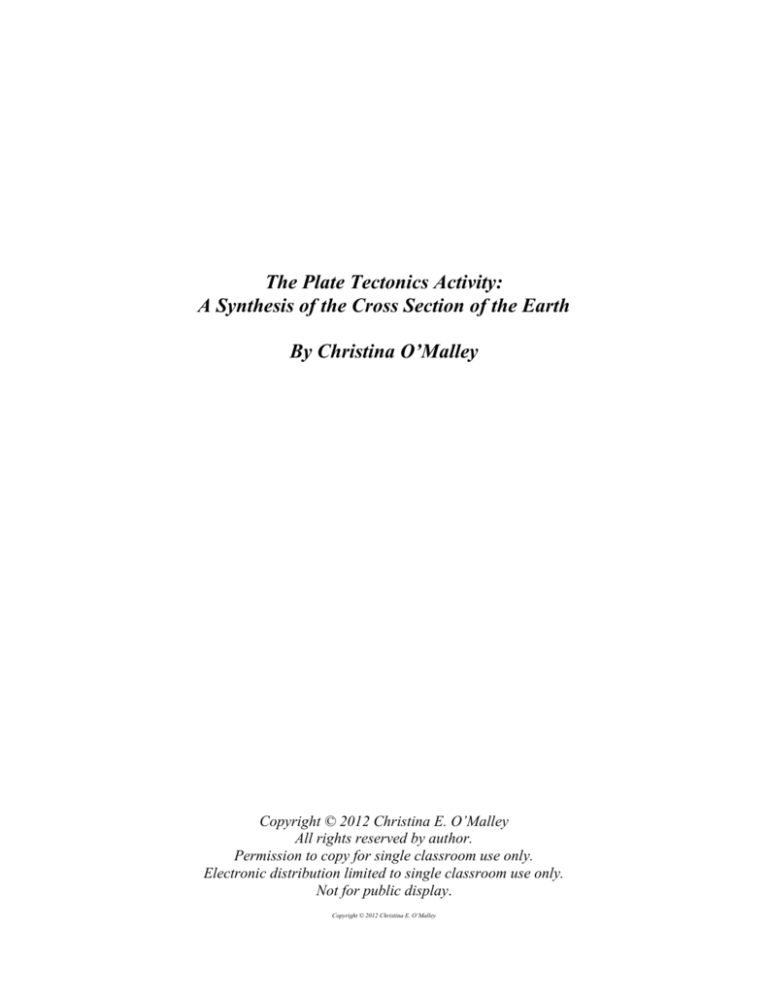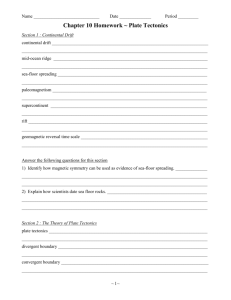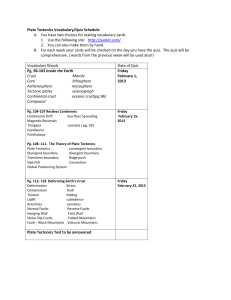
The Plate Tectonics Activity:
A Synthesis of the Cross Section of the Earth
By Christina O’Malley
Copyright © 2012 Christina E. O’Malley
All rights reserved by author.
Permission to copy for single classroom use only.
Electronic distribution limited to single classroom use only.
Not for public display.
Copyright © 2012 Christina E. O’Malley
The Plate Tectonics Activity:
A Synthesis of the Cross Section of the Earth
By Christina O’Malley
Appropriate for grades 7-12, Higher Education (I have used it for both)
Learning Objectives:
The student will be able to:
• distinguish between the roles of the crust, lithosphere, and asthenosphere in tectonic
movement.
• distinguish process involved in seafloor spreading.
• distinguish between convergent and divergent plate boundaries.
• predict the result of a collision between two tectonic plates.
• evaluate a claim and choose the best explanation of whether or why the evidence
supports the theory of plate tectonics.
Materials:
Worksheets (included here)
Blank typing paper
Assorted pens, markers, or colored pencils
Student Grouping:
I allow students to complete this activity in small groups (two people, optimally). This allows
students the opportunity to discuss the decisions they must make to complete the assignment, and
that encourages them to practice using the new vocabulary that they are learning in this lesson.
Methods/Instructional Strategies:
I find this lesson works best when different kinds of crust (continental and oceanic) are
introduced to the students, with an introduction of what occurs when the plates converge (come
together), diverge (pull apart) or slide past each other (such as a transform fault). I also
introduce convection cells, and their role in driving tectonic activity. (Is there a need for a script
of my introduction? I can do that, but I need feedback from you!)
Following the introduction, students divide into groups and work on the assignment. I present it
as a puzzle rather than an assignment. Sometimes I’ve given extra points for the first to finish it
perfectly.
Activities:
Introduction followed by open classtime to work on assignment.
Instructional Modifications/Differentiated Instruction:
This lesson can be modified by the size of paper, art medium, presentation (paper? computer
based? felt? Some kind of 3D model? The biggest limitation is how much time or detail you
want your students to put into this.
Copyright © 2012 Christina E. O’Malley
If you are very limited in time or working with younger students, this student can be simplified
by reproducing the Plate Tectonics Boundary cards for them. Have them cut the cards along the
dotted line, and connect them by matching the type of crust (oceanic or continental) and the
direction of movement to join them into a single cross section.
Resources & Materials (including technology):
I like this one cheap and simple – I do the introduction with a chalkboard/whiteboard, and
students to the activity with paper. It doesn’t make it any less powerful, because our approach to
plate tectonics in the classroom is limited to studying models and proxies.
Assessment/Evaluation:
A rubric is attached that allows the teacher/instructor to assess how successful the students were
in meeting the objectives of the lesson. (Go ahead and let them see it and check their own
work!)
This is a fast-grading rubric – just circle the number of points a student earns on each item and
add ‘em up.
Handouts and Worksheets:
Introduction (suitable for student handout or creating guided notes)
Assignment handout (two pages)
Key for teacher (two pages)
Notes for this lesson
Plate Tectonics Boundary Cards
Rubric
Copyright © 2012 Christina E. O’Malley
Plate Tectonics
Tectonics is the study of large-scale movements and deformation of Earth’s crust and lithosphere. Divergence, or
divergent boundaries, are where plates of the Earth’s crust move away from one another. Convergence, or
convergent boundaries, are where plates of the Earth’s crust move towards one another. You can see examples of
two kinds of boundaries in your lab manual on page 42, Figure 2.10.
Plates – The crust of the Earth is broken into many plates. See Figure 2.6 in you lab manual on page 36 for a
diagram of these plates, and the direction that they are moving.
The earth is composed of several layers. The crust we live
on is only the “top” layer (it is part of the lithosphere), and
is impacted by the flow of the more fluid mantle below it.
Figure from pubs.usgs.gov/gip/dynamic/graphics/Fig32.gif.
Hot spots are
places where
volcanic activity has occurred consistently for very long stretches of
time. Geologists think this is the result of plumes of hot rock rising
rapidly from the mantle.
Figure from
http://www.umt.edu/geosciences/g101/111plates1/hotspot.htm
Copyright © 2012 Christina E. O’Malley
Plate Tectonics
Name: _______________________
Instructions: Complete the sketch described on this page on a separate sheet of paper. Please fill
in your answers for the backside of this sheet on the lab sheet. Do not use a red-ink pen.
It may be useful to sketch each boundary first on scrap paper and then draw them on your lab
sheet – your teacher recommends using a pencil).
Draw a cross section of the earth, including the following types of plate boundaries (there are
5):
Divergent (Ocean – Ocean, Continent – Continent)
Convergent (Ocean-Ocean, Continent-Continent, Ocean-Continent)
Also include the following features:
Convection cell beneath the lithosphere for each boundary. Cells may border 2
boundaries. (You will need at least 6 cells to show the convection).
Use arrows to indicate the direction of the movement of the plates.
A hot spot. May be either on a continent or at sea – your choice.
Draw in the top of the ocean (yes, this is represented by a line).
Label Mountains
Label Trenches
Label Rift Valleys
Your diagram must conform to the following rules. If you break a rule, go fix it on a new sheet
of paper.
1. Plates can only go in one direction, unless there is some kind of labeled boundary where
the direction changes. It is possible to line up all 5 boundaries so you only use each once.
Find them.
2. Continental crust is thicker than oceanic crust.
3. Include the crust and the lithosphere.
4. Convection cells flow like cogs. They won’t flow against each other.
Copyright © 2012 Christina E. O’Malley
Answer the following questions, keeping plate boundaries and tectonics in mind.
Where would you expect to find:
Types of Crust / Relative Direction
Example (a place)
Ocean trenches?
______________________
___________________
Volcanoes?
______________________
___________________
Hot spots?
______________________
___________________
Rift valleys?
______________________
___________________
How are volcanoes on oceanic rock (which is basalt) different from those on the continent?
Of continental and oceanic crust, which kind of crust usually goes into the mantle?
The hardest question: Why is there no ocean-continent divergence?
Copyright © 2012 Christina E. O’Malley
Teacher Notes and Key
This activity will take high-school students or undergraduates approximately 90-120
minutes to complete. It can be completed as a homework assignment, given enough time.
o Expect the “average” student to spend 35 minutes on the diagram part of this lab,
and about 40 minutes on the Q and A. Some individuals may finish in less than
an hour, while others may take the full 2 hours for this assignment.
You will need the following supplies on hand:
o Blank typing paper
o Colored pencils/markers
Distribute the informational handout and double sided assignment sheet to students.
Introduce the following ideas by drawing simple cross sections on your board:
o Oceanic and continental plates are different (discuss differences in density,
isostacy, etc)
o Plates have three kinds of boundaries: convergent, divergent, and transform
boundaries
o Convection cells within the mantle “drive” plate movement
o Hot Spots are where there is a concentrated movement of mantle toward the crust
that sometimes creates volcanic activity at the surface
o Show how mountains are wrinkles in the crust
o Trenches are created at convergent boundaries where a plate is subducting
o Rift valleys form where the continental crust is pulling apart
o The introduction for this can also include ideas about slab pull and slab push, and
some students may add lots of details depending on what you emphasized in your
introduction.
Copyright © 2012 Christina E. O’Malley
Name: _______________________
Instructions: Please fill in your answers for the lab on this lab sheet. Do not use a red-ink pen.
It may be useful to sketch each boundary first on scrap paper and then draw them on your lab
sheet – your teacher recommends using a pencil).
Draw a cross section of the earth, including the following types of plate boundaries (there are
5):
Divergent (Ocean – Ocean, Continent – Continent)
Convergent (Ocean-Ocean, Continent-Continent, Ocean-Continent)
Also include the following features:
Convection cell beneath the lithosphere for each boundary. Cells may border 2 boundaries.
(You will need at least 6 cells to show the convection).
Use arrows to indicate the direction of the movement of the plates.
A hot spot. May be either on a continent or at sea – your choice.
Draw in the top of the ocean (yes, this is represented by a line).
Label Mountains
Label Trenches
Label Rift Valleys
Your diagram must conform to the following rules. If you break a rule, go fix it on a new sheet
of paper.
5. Plates can only go in one direction, unless there is some kind of labeled boundary where
the direction changes. It is possible to line up all 5 boundaries so you only use each once.
Find them.
6. Continental crust is thicker than oceanic crust.
7. Include the crust and the lithosphere.
8. Convection cells flow like cogs. They won’t flow against each other.
Copyright © 2012 Christina E. O’Malley
Answer the following questions, keeping plate boundaries and tectonics in mind.
Where would you expect to find:
Types of Crust / Direction
Ocean trenches?
Volcanoes?
Hot spots?
Rift valleys?
Example (a place)
O-C or O-O / Convergent
Marianas, Peru-Chile, etc
O-C or O-O / Convergent
Mt St Helens, Vesuvius, etc
O or C / Not a boundary
Yellowstone, Hawaii
C-C / Divergent
Great Rift Valley, Death Valley
How are volcanoes on oceanic rock (which is basalt) different from those on the continent?
Oceanic rock is denser, than felsic continental rock. Felsic volcanoes are more explosive, mafic
volcanoes have slow and oozy lava. (Go for the ideas here, not the words).
Of continental and oceanic crust, which kind of crust usually goes into the mantle?
Oceanic
The hardest question: Why is there no ocean-continent divergence?
Think of any divergence – in the end, you get an ocean basin with basaltic rocks. This is because
oceanic (basaltic) rocks reflect the chemistry of magma. Because continental rocks are felsic and
magma fills the voids between two plates, you will not have a sustained O-C divergent margin –
it will become a O-O divergent boundary (example: rift between S. America and Africa).
Copyright © 2012 Christina E. O’Malley
Part one sketch example:
MORE TEACHER NOTES
Colors in the above diagram are meaningless, they are only colored that way so
that the direction stands out a bit more. Some students may colors these red and
blue to indicate relative heat, and if you notice this you may want to make sure
they aren’t representing alternating “hot” and “cold” cells.
To save time, distribute the Plate Tectonics Boundary Cards to students/student
groups and have them match the sides of the cards by plate type and direction.
Use the RUBRIC on the last page to score the cross sectional diagram.
Copyright © 2012 Christina E. O’Malley
Copyright © 2012 Christina E. O’Malley
Plate Tectonics Cross Section Project RUBRIC
Content (up to 30 pts)
Shows all 5 plate boundary combinations: 5 4
Shows 6 convection cells in proper place: 6 5
Shows 6 plates, moving in correct direction: 6 5
Labels type of boundary (5 types):
5 4
Shows hot spot:
1 0
Shows ocean:
1 0
Labels 2 trenches:
2 1 0
Labels mid-ocean ridge:
1 0
Labels rift valley:
1 0
Labels mountains (2):
2 1 0
3
4
4
3
2
3
3
2
1
2
2
1
0
1 0
1 0
0
Creativity (up to 20 pts)
Use of color: 10 9 8 7 6 5 4 3 2 1 0
Penmanship: 10 9 8 7 6 5 4 3 2 1 0
Short response questions:
10 9 8 7 6 5 4 3 2 1 0
“The Hardest Question”: 10 9 8 7 6 5 4 3 2 1 0
--------------------------------------------------------------------------------------------------------------------Plate Tectonics Cross Section Project RUBRIC
Content (up to 30 pts)
Shows all 5 plate boundary combinations: 5 4
Shows 6 convection cells in proper place: 6 5
Shows 6 plates, moving in correct direction: 6 5
Labels type of boundary (5 types):
5 4
Shows hot spot:
1 0
Shows ocean:
1 0
Labels 2 trenches:
2 1 0
Labels mid-ocean ridge:
1 0
Labels rift valley:
1 0
Labels mountains (2):
2 1 0
3
4
4
3
2
3
3
2
1
2
2
1
Creativity (up to 20 pts)
Use of color: 10 9 8 7 6 5 4 3 2 1 0
Penmanship: 10 9 8 7 6 5 4 3 2 1 0
0
1 0
1 0
0
Short response questions:
10 9 8 7 6 5 4 3 2 1 0
“The Hardest Question”: 10 9 8 7 6 5 4 3 2 1 0
Copyright © 2012 Christina E. O’Malley










